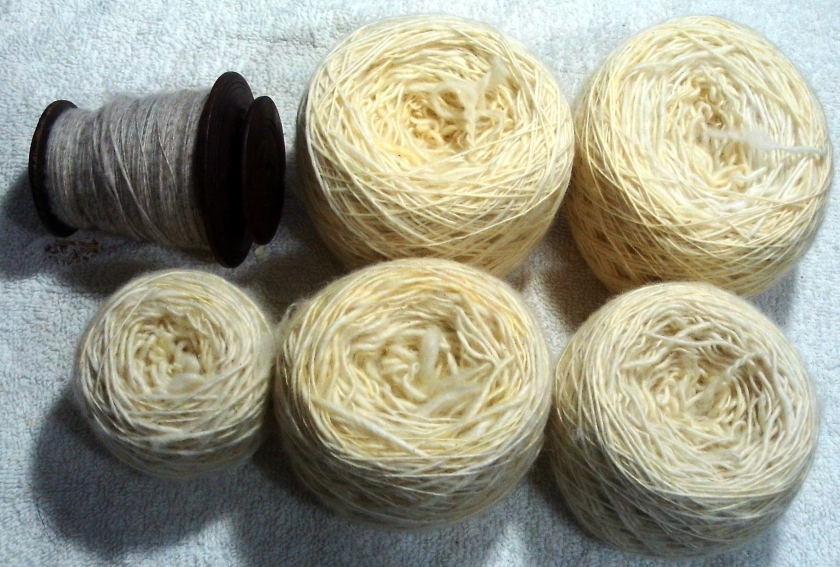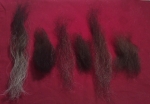I’m sorry for neglecting you for the last month. I’ve been unbelievably busy.
When I last posted I told you about my Icelandic fleece haul. I’m happy to say that I’ve got just 2 days of scouring left – half of an adult fleece and several lamb fleeces.
Here are sample yarns and locks from some of the fleeces.
I had more pics but seem to have misplaced them. You can always go here to my fiber stash page on Ravelry to see more. Left – locks. Middle – Tog and Thel separated (and some carded Thel bits from the white fleece that has a break). Right – sample yarns, Tog on left and Thel on right.
Tog is the coarser outer coat and Thel the soft inner coat.
As for Tdf, I spun all of the white Shetland, prepped and spun some Corriedale to finish a WIP sweater.

The Shetland has been plied but I don’t have a pic of that yet. The Corriedale is still in progress.
I had an amazing find as well. Credit must go to my husband, who spotted it first and then bought it for me as a 25th anniversary present (as if 80+ lbs of Icelandic fleece wasn’t enough of a present, not that I’m complaining.)
A Kromski Mazurka spinning wheel for $75 at a thrift store. It also came with a lazy kate and an extra bobbin. While I will always love my antique wheel, I adore this new wheel. It’s in perfect condition. It doesn’t appear to have even been used. It spins like a dream and plies like an even better dream. The antique has always been extremely fussy about plying and it’s always a battle to ply on it. The Mazurka barely fusses at all.
I’ve also started processing some of the Icelandic fleece. First up is Sugar’s Spring fleece.
On the left is Tog, pulled from the locks. The right is Tog nests, carded Thel waste from combing and the Thel nests. I’ve done a bit more than what is pictured.
The initial Icelandic goal is to spin a thickish skein of each adult fleece and then knit 2 hats for the sheep owners. After that, the Tog will be spun for weaving warp and the Thel for knitting, hopefully I’ll get a lot of laceweight out of one of the whites to be dyed for shawl knitting. I’m also pondering a all natural color colorwork sweater.
I don’t intend to make any Lopi-style yarn. I don’t like it. Although there are a few fleeces that will have Tog and Thel processed together, particularly the lamb fleeces, only because the Tog is very soft on those fleeces. Most of the Tog is too coarse for against my skin. One of them, Luke, has Tog that’s too coarse for anywhere on my body, even over other clothing.
The husband is planning to make a drum carder for me. I can’t wait for it to be ready. It’ll make all of this Icelandic prep go much faster. It’s very time consuming to separate and comb both Tog and Thel. And I am still saving the combing waste of the Thel because it is so very soft. I’ll card that, hopefully on the drum carder. I’m not very good with hand cards.

































